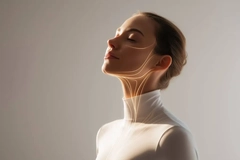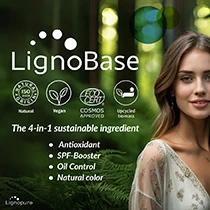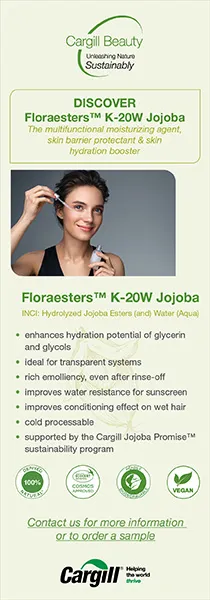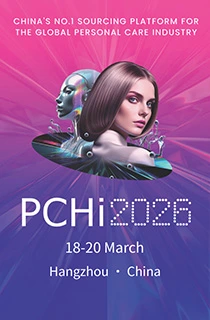Harnessing the hidden world of microorganisms for natural pigments and functional beauty ingredients
20 Mar 2023 --- The study of microorganisms has revolutionized how we think about skincare and beauty. Recent studies have shown that the trillions living on and within our bodies play a vital role in the health of our skin. Scientists are further harnessing microbial activities for synthesizing new potent ingredients. Meanwhile, microalgae-based pigments spotlighted in clean label formulas for their heat stability and vibrant color.
PersonalCareInsights explores the latest developments in this dynamic field.
“Let’s get it out there: you are actually only about 50% human,” highlights Dr. Samantha Samaras, global VP of science & technology at Unilever’s Beauty & Wellbeing and Personal Care business group.
“Nearly half of the genetic material in and on your body is not human, and when we talk about the microbiome, we’re talking about more than 100 trillion microbes,” she notes. “The fellow travelers that have evolved in partnership with our bodies over millennia and how they play important roles, good and bad, in our health and well-being.”
“These microbes live in us and on us, from the top of our scalp to the tips of our toes and everywhere in between – from our mouth to our skin to our intestines. And we’re just getting started when it comes to understanding how the microbiome and our bodies interact.”
 Many microbial pigments have gained attention as interesting bioactive molecules with potential health advantages, as well as low cost, stability and biodegradability.Microbiome research that would have taken decades is now taking months with AI, according to Dr. Samaras. “ We are able to create computational models that can simulate biological processes. And we can understand much more quickly how the skin is reacting to ingredients that can boost its own natural immunity. ”
Many microbial pigments have gained attention as interesting bioactive molecules with potential health advantages, as well as low cost, stability and biodegradability.Microbiome research that would have taken decades is now taking months with AI, according to Dr. Samaras. “ We are able to create computational models that can simulate biological processes. And we can understand much more quickly how the skin is reacting to ingredients that can boost its own natural immunity. ”
Unilever has learned that introducing a specific ingredient to a hand wash product can feed the skin, boosting its antimicrobial peptides (AMPs). These AMPs help form the first line of natural defense against infection-causing microbes that land on your skin.
Unilever’s brand of liquid hand wash Lifebuoy Vitamins is infused with vitamins B3 and E, which boosts the skin’s production of AMPs, leaving it clean, moisturized and protected from bacteria for up to ten hours.
“It’s a discovery that has huge potential to help improve hygiene and fight preventable disease,” says Dr. Samaras.
Last February, Australia’s first microbiome-focused haircare brand Straand inked a deal with Unilever Ventures to fund global expansion. Straand launched four prebiotic scalp balancing products, including The Crown Cleanse, The Crown Fix Serum, The Head Doctor Conditioning Treatment and The Miracle Worker Scrub, along with a premium range of accessories.
“The investment will help pave the way for the brand’s expansion into the US, UK, Europe and China. Dandruff and broader scalp concerns are a significant and much maligned condition globally,” says Rachel Harris, partner at Unilever Ventures.
“There has been limited innovation in the scalp health category for many years and it is ripe for disruption. Straand stood out with its microbiome-focused formulations, bold branding, youthful appeal and affordable positioning.”
In December, Unilever partnered with the University of Liverpool’s Microbiome Innovation Centre and Brain & Behaviour laboratory to uncover the links between the microbiome, its effects on the skin and overall well-being.
Microbial rainbow of pigments
Industrial pigments used to create colors in cosmetics such as nail polish and lipstick are often made from potentially harmful chemicals like benzene and toluene. Consumers are growingly aware of the impact of these synthetic dyes, raising the demand for natural pigments.
In this field, many microbial pigments have gained attention as interesting bioactive molecules with potential health advantages, as well as low cost, stability and biodegradability.
 Pioneering UK-based wellness brand Hæckels created a unique ingredient called Spiraglow, which is a microbiologically optimized element that contains algal polysaccharides to provide prebiotic hydration (Image credit: Hæckels).Microbial pigments have several applications in the field of cosmetics due to their photoprotection, antioxidants and anti-aging properties, including inhibiting melanogenesis and acting as natural colorants for cosmetics, as some microorganisms are rich in pigments.
Pioneering UK-based wellness brand Hæckels created a unique ingredient called Spiraglow, which is a microbiologically optimized element that contains algal polysaccharides to provide prebiotic hydration (Image credit: Hæckels).Microbial pigments have several applications in the field of cosmetics due to their photoprotection, antioxidants and anti-aging properties, including inhibiting melanogenesis and acting as natural colorants for cosmetics, as some microorganisms are rich in pigments.
“There is a wide spectrum of color seen in microbes, including cream, yellow, orange, pink, red, purple, green, grey, brown, black, blue, indigo and metallic green,” detail researchers from the University of Jeddah, Saudi Arabia, writing in the journal MDPI. “Microbial pigments can be categorized based on their chemical, visual and spectral properties and their origin.”
“While certain microorganisms are rich in pigments including melanin, carotenoids and phycobiliproteins, the manufacture of natural colorants for cosmetics (such as eyeliners, eye shadows, lipsticks, etc.) might be another area of interest. Hence, the beauty sector may be interested in more thorough studies to discover novel colors from microbial cells.”
Phycocyanins, produced by thermophilic blue-green algae, have been used to create eye shadow and Japanese company Ink has used phycocyanin extracted from Spirulina sp. as a coloring agent in eye makeup. Phycocyanins’ stability makes them a significant component in cosmetic products. They have also been examined for their antioxidant, immune-boosting and anti-inflammatory properties.
The strong green pigmentation of microalgae yields easily extracted pigments, such as chlorophyll, for cosmetics. “In particular, chlorophyll from chlorophyte is employed as a colorant and in anti-inflammatory product,” the researchers note.
Other scientific investigations uncovered that chlorophyll has the potential to cover unpleasant smells, making it a useful component in deodorants, toothpastes and other personal care products.
Meanwhile, natural pigments from red microalgae can also be used to create pink and purple cosmetic colors, including lipstick and eyeshadow creams or powders. “For example, lipstick and eye shadow were developed in the form of creams or powders with pigments extracted from different red microalgae,” detail the researchers.
Moreover, phycobiliproteins derived from the red microalgae species Porphyridium aerogineum are utilized as pigments because they are not affected by pH (4, 5). Their color also remains stable under light.
Melanin and chlorophyll
The Jeddah study highlights patent (US6740313 B2), which discloses that ankaflavin, one of the principal pigments derived from Monascus sp. – a species of mold that is purplish-red in color – generates a long-lasting skin pigment that resembles a natural tan. This pigment immediately colored well in a skin test in vitro.
In another report, a bio-based lip balm prepared from a crude pigment extracted from Streptomyces bellus in a combination of shredded bee’s wax, lanolin and coconut oil evidenced the use of melanin pigment as a major component in a variety of beauty products.
There is still significant interest in discovering new sources of blue natural pigment for industrial applications, as blue pigments are uncommon in nature. Even manufactured blue colorants have stability challenges. “Therefore, new sources of blue pigments need to be discovered, especially in terms of compounds of a natural origin, since they will have stronger commercial appeal,” highlight the researchers.
“The future of microbial pigments will be more colorful and brighter if researchers improve purification and extraction methods to meet the rising demand of the global market. This includes looking for safe environmental methods, using fewer solvents and energy and making them easy to scale up.”
Harnessing algae for probiotic power
Hæckels, a pioneering wellness brand, operates out of a former betting shop located in Margate, England. The company specializes in a range of sustainable skincare products, including fermented elixirs, bio-contributing mycelium casing and self-composting vivomer packaging.
 Hæckels’ Lab System line of skincare products made using the Spiraglow ingredient (Image credit: Hæckels).The company’s new “Innovations” arm has expanded with the addition of Hæckels’ Lab. Within this division, three science-backed skincare products – coined the “Lab System” – aim to address the issue of harmful ingredients through innovative lab-grown solutions. All three products in the range are verified as “Kind to Biome,” and are designed to have a transformative effect on the skin.
Hæckels’ Lab System line of skincare products made using the Spiraglow ingredient (Image credit: Hæckels).The company’s new “Innovations” arm has expanded with the addition of Hæckels’ Lab. Within this division, three science-backed skincare products – coined the “Lab System” – aim to address the issue of harmful ingredients through innovative lab-grown solutions. All three products in the range are verified as “Kind to Biome,” and are designed to have a transformative effect on the skin.
Lab Spiraglow EGF Serum is intended to deeply moisturize and smooth the skin, while the Spiraglow Cleansing Milk can help to soothe and hydrate the skin. Meanwhile, the Spiraglow Hydrating Toner is formulated to hydrate and soften the skin.
Each product in the range contains a unique ingredient called Spiraglow, which is a microbiologically optimized element that contains algal polysaccharides to provide prebiotic hydration. Clinical studies have shown that Spiraglow can improve skin elasticity and reduce the appearance of wrinkles and lines by up to 22.1%.
“For the last two years we have been working on improving our product range, expanding our offering and listening to the great feedback you give us,” details a Hæckels spokesperson.
“One of our biggest challenges was that we had too many ideas. We wanted to create everything and that simply isn’t possible in a business of our scale. So, we’ll be releasing new products consistently over the next 12 months. This will include toners, anti-pollution treatments, face and hair oils and many, many more.”
By Benjamin Ferrer













